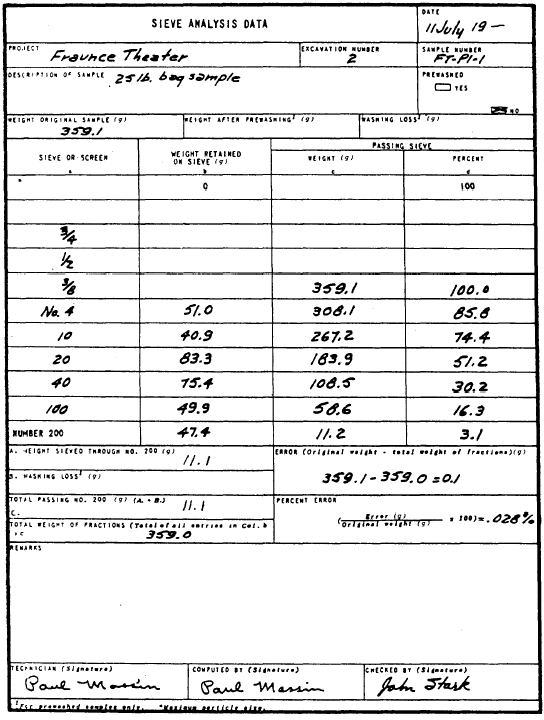|
SIEVE ANALYSIS, DRY. The
minimum sample weight required for
a sieve analysis is dependent upon
the maximum particle size in the sample
as follows: Maximum particle size Minimum dry weight (sieve
opening) of test specimen
3 in. 6,000 g
1 1/2 in. 3,000 g
3/4 in. 1,500 g
3/8 in. 600 g
No. 4 200 g
Samples that contain cohesive soil, which forms
hard lumps, must be prewashed. This procedure is
described later. Other samples are analyzed
DRY by the following procedure:
1. Oven-dry the sample.
2. Break up lumps. For coarse material, use a
rolling pin on a clean, hard, smooth surface. For
fine material, use a mortar and pestle (usually a
part of the laboratory apparatus). Take care not to
crush individual grains. The object is to separate
aggregations of clustering grains.
3. Weigh the sample.
4. Select and weigh the sieves and pan to be used
in the test. The sieve selection varies according
to the type of soil being tested. The following
is a selection commonly used:
3 in. (76.2 mm)
No. 10 (2.00 mm)
1 1/2 in. (38.1 mm) No. 20 (1.21 mm)
1/2 in. (12.7 mm) No. 40 (0.42)
mm
3/8 in. (9.52 mm) No. 100 (0.149
mm)
No. 4 (4.76 mm) No. 200
(0.074 mm)
Stack (nest) the sieves one on top of the other such
that the largest sieve is on top. The coarsest sieve
actually recorded is the next above the first one
that retains any material. The weight recorded as
retained on this sieve is 0 g; the weight recorded
as passing it is the total weight of the sample.
5. Place the sieve pan under the stack of sieves;
place the total sample in the top sieve and shake.
The shaking interval depends on the amount
of fine material. Five minutes is usually enough
for most coarse-grained soils, and 15 min is
enough for most fine-grained soils.
6. Remove the sieves from the shaker. Start-ing with
the first to retain any material, carefully weigh
each sieve with the retained material. Sub-tract the
weight of the sieve from the combined weight
of the sieve and material to determine the weight
of the material retained on each sieve. Finally,
determine the weight of the material that reached
the pan; that is, that passed the No. 200, or
finest, sieve.
Enter the results on a data sheet like the one shown
in figure 15-31. In this analysis, all the material
(359. 1 g) passed the 3/8-in. sieve; none was
retained on this one. The No. 4 retained 51.0
g. This means that 308.1 g (359.1 51.0) passed
this sieve. You can see how the weight pass-ing was
determined from the weight retained in each
subsequent case. In column d, the percent passing
is computed for each sieve by multiply-ing the
weight passing by 100 and dividing the result
by the total weight of the sample.

Figure 15-31.-Data sheet for dry
sieve analysis.
The total weight of fractions plus the weight of
the material that reached the pan comes to 359.0
g. The weight of the sample originally was 359.1
g; there is an error here of 0.1 g. At the lower
right, you can see how the percentage of error
is computed. The maximum permissible percentage
of error is normally () 1 percent. If the
percentage exceeds the maximum, the test must
be rerun. For an error smaller than the maximum permissible,
correction is made by adding the
value of the error to the largest amount listed as
retained. The value of the error in this case is 0.1
g. The largest amount retained is 83.3 g for the
No. 20 sieve. This amount would be changed to
83.4 g.
|


|

